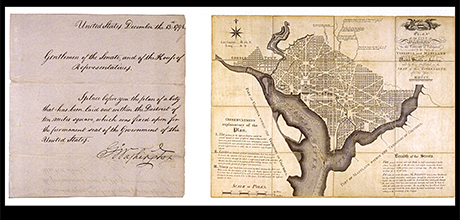George Washington University students researching pieces from the Albert H. Small Washingtoniana Collection learned that although objects can’t talk, the questions you ask about them can reveal a plethora of new and interesting stories.
Albert H. Small, a 2009 recipient of the Presidential National Humanities Medal, donated his rare drawings, maps, letters and documents to the university in 2011 to help establish GW’s new museum, set to open in 2014. The collection chronicles the history of the nation’s capital from the 18th to the 20th century, and it will be permanently displayed in the new museum’s Woodhull House.
James Goode, an author and historian who worked closely with Mr. Small for many years, is writing a book on the collection. He selected about 70 of the most important pieces in the collection and reached out to the university to help gather intensive research on each artifact.
Professor of Museum Studies Laura Schiavo, Ph.D. '03, and Professor and Chair of the Department of History William Becker led students on semester-long research studies of the pieces selected by Dr. Goode. Dr. Schiavo helped guide a handful of museum studies graduate students, while Dr. Becker worked with five history undergraduates.
The students’ work will be published in Dr. Goode’s book, which will be released when the university’s new museum opens. Additionally, Gabriella Angeloni, B.A. '13, senior Andrew Kaiser and museum studies graduate student Maggie Leak were selected to present their findings at a symposium with Mr. Small on Oct. 15.
“This project is particularly nice because it gives students a chance to both conduct extensive research on these objects, and also write about them in a clear and concise way,” Dr. Schiavo said.
Dr. Schiavo and Dr. Becker each chose between one to three students to work with last spring. This semester, Dr. Schiavo added one more student to the project. Each student met with Dr. Goode about their assigned piece and set off on a quest to gather as much research as possible.
Students spent countless hours flipping through documents at the National Archives, talking to librarians at the Historical Society of Washington, D.C., and poring through related research at the Library of Congress.
Ms. Leak studied an 18th-century map made by surveyor John Frederick Augustus Priggs. She used her art history background to form questions not just about what was drawn on the map, but about how it was made. She examined the map’s hand-drawn quality, the decorative iconography used and the time period when it was created. She also contacted scholars who could give her more insight about the piece.
Ms. Leak noted Mr. Priggs made the map toward the end of his career—a clue that perhaps indicted he’d created it as a hobby. It was believed the map had been used for practical purposes, but using her findings, Ms. Leak concluded the piece may have been intended for décor or commemoration.
“I was surprised to learn about the differing opinions of scholars who were familiar with the map. After interviewing some of them and comparing the map to others from that time, I was able to piece together what I consider to be a new interpretation of this object,” Ms. Leak said.
Dr. Schiavo called Ms. Leak’s research on the project one of the most rewarding experiences, because Ms. Leak was able to approach the object in a new way, and come to her own, original conclusions.
“The questions she asked were different than a historian—she used her art history knowledge and looked at the materials, the medium, the ink. She ended up with a very interesting thesis about why this particular map was drawn,” Dr. Schiavo said.
Dr. Schiavo said that in addition to providing students with experience in original research, the project also aligns with the intent of Mr. Small’s donation.
“When Mr. Small decided to give the collection to GW, he wanted his collection to be used by students, researchers and faculty. He didn’t want it to be stored away somewhere. It’s been wonderful that we can have students doing this hands-on work with his collection,” she said.


